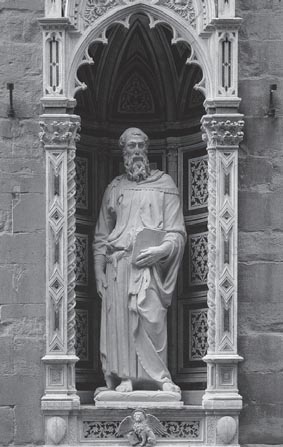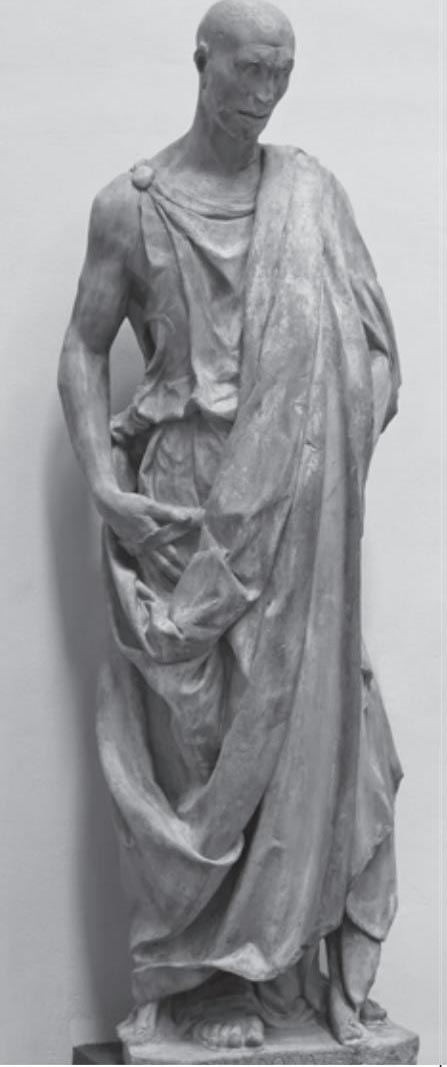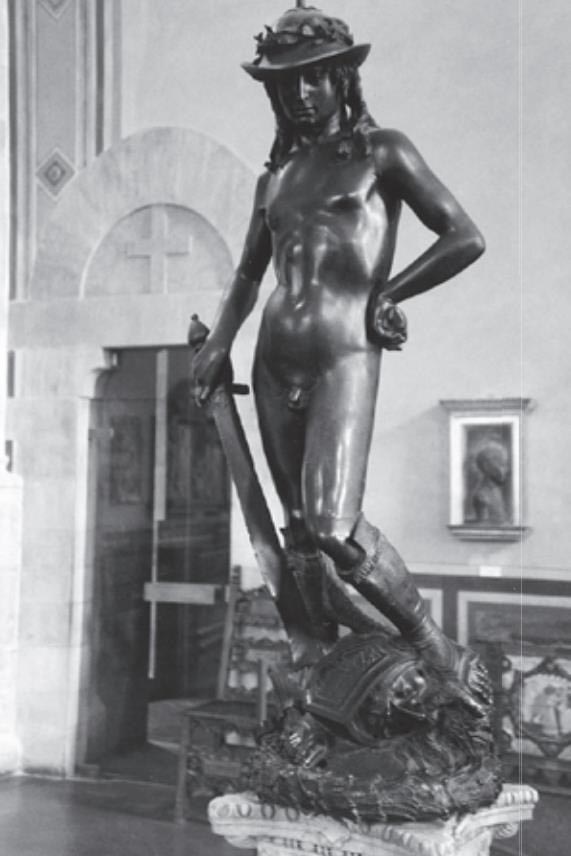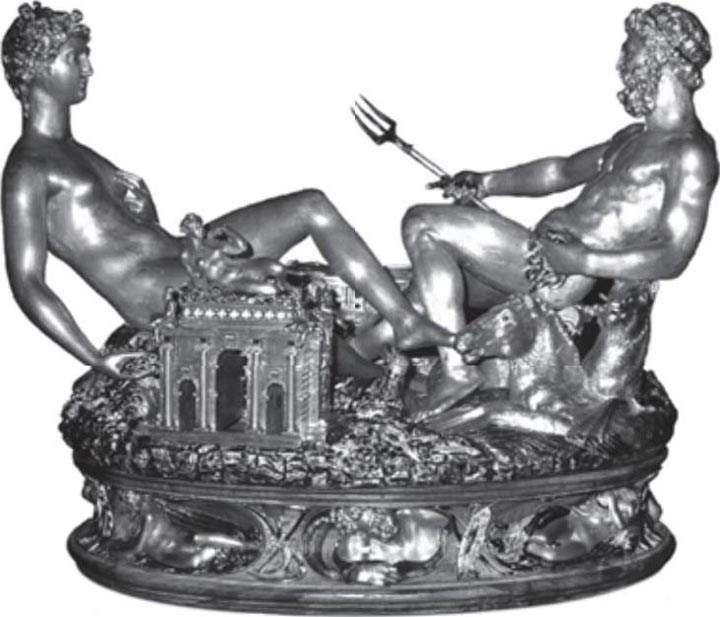






大理石雕像《圣马可》

The Italian Renaissance re-established Western art according to the principles of classical Greek art, especially Greek sculpture and painting. It was driven by the new notion of "Humanism, " a philosophy which had been the foundation for many of the achievements (democracy) of pagan ancient Greece. Humanism downplayed religious and secular dogma and instead attached the greatest importance to the dignity and worth of the individual.Prestigious artists in this era included Donatello, Michelangelo Italian Renaissance Sculpture reflected the primacyof the human figure, notably the male nude. Both Donatello and Michelangelo relied heavily on the human body. Both of them had chosed David, a Biblical figure, a shepherd who killed the giant Golia from another tribe, as their subject, and they had both portrayed David as a naked young man. In the Medieval Era, only Adam, Eve, crucified figures and St. Sebastian who was burned to death, could be presented in nudity.
意大利文艺复兴运动复兴的是古希腊的经典思想和艺术风格,尤其是古希腊的雕塑和绘画,其基本理念是“人文主义”,这是在希腊时期许多重要成就的原动力(如民主制度)。人文主义不强调宗教的重要性,而是把人的尊严和价值放在第一位。这一时期最杰出的雕塑家有多那泰罗和米开朗基罗。
意大利雕塑非常重视对人体的展现,特别是裸体的男性。多那泰罗和米开朗基罗的作品都鲜明地体现了对人体的研究。他们两人都曾经为《圣经》故事中的大卫创作过雕塑,这个牧羊少年勇敢地杀死了异族前来挑衅的巨人歌利亚。他们的《大卫》像都赤身裸体,而在中世纪,只有亚当和夏娃,以及被钉在十字架的人和被拷打致死的圣塞巴斯蒂昂才能如此。
Donatello's statue of St . Mark was a turning point from the Medieval Era to Renaissance in that he revived the use of the contrapposto stance in freestanding sculpture. Contrapposto had been employed by many ancient Greek and Roman sculptors, dating back to the Classical period of Greek art beginning around 480 B.C. After the fall of the Roman empire, however, it was largely forgotten by Europeans in the Medieval Era. When medieval sculptors depicted the human figure in reliefs, the figures would often times be given stylized body parts and rigid postures.Donatello started to change this in large-scale freestanding sculpture by giving St. Mark a much more natural look through the use of contrapposto.The wrinkles on the clothes seem to be flowing with the movement of the body, as if it was real blood andflesh beneath.

《哈巴谷先知》

Donatello learned from classical art throughout his long career and got rid of the restrictions set by Medieval Ages. He tried different ways to express life and himself, drawing from the realistic approach of the ancient Greek and Roman sculpture. In his later years, he gradually began to show his individual touch in his works and express his feelings uninhibitedly. During his senior years, he experimented with expressing beauty through ugliness.
Donatello's Prophet Habacuc , created in his forties, was a watershed work. The figure has no graceful face or careless folding in the clothes, presenting nothing but a thin and sad ordinary person. He has a pointy and narrow head, mouth gaping, and the wrinkles in his face seem to be the consequence of years of sadness. His eyebrows tilt downward and his eyes are clouded by a layer of woeful haziness. His body erects helplessly under the weight of the heavy clothes. Habacuc is a thinking, lamenting and emotional person, experiencing the pain imprinted upon the soul of human beings. Such kind of "ugliness" broke the standard of posture beauty exulted by Florence in Renaissance. It was said that after the work was completed, Donatello yelled at it: "Say it, spit it out, open your mouth and talk."
Donatello's David was the first totally naked human figure in the Renaissance. He did not give the young man a stunning beauty, but made him an ordinary shepherd holding the stone that killed the enemy and Goliath's sword. He does not seem like a hero but rather a handsome boy wearing a Florence cap, looking at the severed head by his feet in a carefree way. He is full of confidence and unconstrained. He likes being a victor and show off his feat as the whole world is in his command. Individuality is his ultimate aim.
多那泰罗的《圣马可》塑像标志着一千多年的中世纪美术的结束和文艺复兴美术时代的开篇,因为他运用了已经封尘多年独立雕像的
对称手法
 。对称法在古希腊和古罗马十分流行,可以追溯到公元前480年的希腊古典时期。罗马帝国覆灭以后,中世纪的艺术家们似乎不会灵活使用这种手法,他们在浮雕作品中运用对称法的时候,人物的动作就显得太刻板。而多那泰罗则改变了这种状况,他将对称手法用于《圣马可》的造型中,让他看上去更加自然。作品中,人物的衣服似乎随着躯体的运动而活动起来,衣褶围绕着任务躯体的摆动产生了相应的变化,让人感到衣服所覆盖的是活的人体。
。对称法在古希腊和古罗马十分流行,可以追溯到公元前480年的希腊古典时期。罗马帝国覆灭以后,中世纪的艺术家们似乎不会灵活使用这种手法,他们在浮雕作品中运用对称法的时候,人物的动作就显得太刻板。而多那泰罗则改变了这种状况,他将对称手法用于《圣马可》的造型中,让他看上去更加自然。作品中,人物的衣服似乎随着躯体的运动而活动起来,衣褶围绕着任务躯体的摆动产生了相应的变化,让人感到衣服所覆盖的是活的人体。
多纳泰罗在他漫长的一生中不断从古典艺术中汲取营养,努力摆脱中世纪雕塑的种种束缚,尝试用各种雕刻形式来表现现实生活。在接受了古希腊、古罗马写实雕刻的手法以后,他渐渐显示出自己的个性,毫无遮拦地表达自己的思想和情感,甚至在他的暮年进入了“丑的美”的写实主义中去。

多纳泰罗的如孩童般的《大卫》

最能表现他的个性的作品是他40多岁时创作的《哈巴谷先知》雕像,这座先知像与之前的作品完全不同,没有了庄重的容貌,没有安排巧妙的衣褶,只是一个非常消瘦与忧愁的普通人。他的头尖尖的、窄窄的,张着嘴,脸上的皱褶是他多年来忧虑的结果,低侧眉头表现了他的困顿,他的双眼被一层悲哀的薄雾给蒙住了,身体也似乎因支撑不住沉重的衣服而无力地耸在那里。哈巴谷是一个正在思索、痛苦、感动的人,这是印在人类灵魂上的苦恼。多纳泰罗表现的这副雕像,使作品丑的更明显,中世纪艺术一向追求的造型美至此被多纳泰罗完全放弃了,据说在雕像完成后,多纳泰罗对着雕像大喊:“你说,你说,开口好了。”
多那泰罗的《大卫》是文艺复兴时期最早出现的全身裸体的雕塑,他没有理想化的外貌,而是一个普通少年牧人的样子。他左手拿着一块圆石头,用它击中了敌人的脑穴,右手握着敌人的宝剑;他不再是旧约故事中的英雄,而是一个英俊的小伙子,仅戴着一顶佛罗伦萨小帽,以漫不经心的优雅姿态望着脚下敌人的头颅;他十分自信,不受习俗束缚,喜欢摆出优越者的姿态。他把自己看成一个受他控制的世界的中心,个性的自由就是他的最高目标。
A 26-year old Michelangelo sculptes the Statue of David , which is more than 5 meters high, between 1502 and 1504 from a single piece of poor quality marble other sculptors had rejected. The statue shows a young man, naked in the way that statues of ancient gods were made, just pausing for a moment and looking with fierce eyes at the huge soldier Goliath that he is about to kill. David has a determined, focused look in his eye. You can see the veins in his hands and the clear outline of his rib cage. His elbows appear calloused and rough and his feet are crusty and cracked. His cheeks are smooth. His nostrils are slightly flared, his brow mildly furrowed and his hair classically curly. The work candidly shows the sculptor's appreciation of human body.
Michelangelo's Pieta shows the Virgin Mary with the body of Jesus in her lap after the Crucifixion. Michelangelo was 23 when in 1499 he created the beautiful Pieta from a vast block of the best marble from the quarries in Tuscany. Due to the sublime perfection of this work and given the youth of Michelangelo, some questioned whether he was the true author giving his work to the devoted "Leonardo da Vinci". When the rumor already circulating throughout the city of Rome reached his ears, in an outburst of fury he sculpted on the finished image a tape across the chest of the Virgin in which you can read "Michael Angelus Bonarotus Florentinus Faciebat"(Michelangelo Buonarroti, Florentine, made it). Since then, Michelangelo began his road to glory and admiration of his contemporaries. The sculpture is in the shape of a stable Pyramid and has a strong realistic detailed touch.The loose clothes of the Virgin cover the actual proportion of her body so that the sculptor could make better composition. The naked and lifeless body of Jesus forms a contrast to the flowing texture and morning expression of the Virgin. The sculptor carefully processed the work and even used velvet to polish the stone until the surface was completely smooth. The sculpture created a sensation when it was unveiled in Rome, and since then remained as one of the most brilliant work in art. It is now housed by the St. Peter's Basilica in Vatican.
米开朗基罗的《大卫》雕像是在他26岁时创作的,雕像连基座高达5米多,1502~1504年,他利用一块其他雕刻家都看不上眼、质量很差的大理石创作了这个名垂青史的雕像。作品展现了一个裸体的年轻男性在向敌人歌利亚投掷石块之前最后的准备动作,他目光如炬,散发出坚定而集中的光芒,瞄准敌人,可以看到他手上的经络和层层分明的肋骨。他的肘部长了茧,十分粗糙,双脚也被劳作磨得开了裂,双颊皮肤光滑,鼻翼微张,眉毛轻轻皱起,头发卷曲。作品重复展现出雕刻家对于人体之美的赞赏。

米开朗基罗的《大卫》

米开朗基罗的另一件重要作品《圣母怜子》像展现了基督被处死之后被圣母抱在怀里的情景。米开朗基罗创作这件作品的时候年仅23岁,材料是从意大利托斯卡纳区采来的一块上等大理石。因为作品的精妙和作者的年纪似乎不相符,有人怀疑这不是出自米开朗基罗本人之手。当谣言传到他耳朵里时,愤怒的米开朗基罗在已经完成的雕像上又刻了一条绕在圣母胸前的带子,上面刻着:“米开朗基罗·博那罗蒂,佛罗伦萨人,创作此像。”从那以后,他一举成名。作品采用了稳重的金字塔式构图,具有强烈的写实技巧,圣母宽大的衣袍既显示出她四肢的形状,又巧妙地掩盖了身体的实际比例,解决了构图美与人体实际比例之间的矛盾问题。基督那脆弱而裸露的身体与圣母衣褶的厚重感以及清晰的面孔形成了鲜明的对比,统一而富有变化。作者对雕像进行了极其细致入微的打磨工作,甚至使用了天鹅绒进行摩擦,直到石像表面完全平滑光亮为止。作品一经展出,立即轰动了整个罗马城,从此它便与作者米开朗基罗的名字一起成为了艺术史册中光辉的一页。雕像现存于梵蒂冈圣彼得大教堂内。

切利尼的雕塑作品

Mannerism sculpture figured importantly in High Renaissance. The term, derived from the Italian word "maniera" meaning style or stylishness, refers to a style of painting, sculpture and architecture, that emerged in Rome and Florence in late 16th century. Mannerism acts as a bridge between the idealized style of Renaissance art and the dramatic theatricality of the Baroque. The certainty of man being the measure of all things was shattered.In 1517, Martin Luther declared the religious war of the Reformation against the Catholic Church. For the Protestants, the papacy had become the epitome of universal moral and religious decadence. Painters—like many of their contemporaries—lost their faith in ordered harmony. They were of the view that the rational laws of art based on equilibrium, were no longer sufficient to illustrate a world that had been torn from its axes. To this extent, the art of this period Mannerism-is the art of a world undergoing radical change, impelled by the quest for a new pictorial language. It stressed imagination, distinctive individual style, exaggeration and details rather than rationality and order.

切利尼的《金盐盒》,1543年完成,现藏于维也纳国家艺术馆
Mannerist sculpture was more expressive than its Renaissance predecessor, and which was exemplified by sculptors such as Benvenuto Cellini and Giovanni da Bologna. Cellini's Perseus with the Head of Medusa , Perseus stands naked except for a sash and winged sandals, triumphant on top of the body of Medusa with her head in his raised hand, a beautiful woman whose hair was turned to snakes and any man that looked at her was turned to stone. Blood is drooping from the head and the indignation in Perseus' face is yet to receed.
Cellini was at the same time a master of metallic art. His exquisite and luxurious Salt Cellar created sensation when it first saw the daylight. The cellar is built upon an ellipse base with two graceful naked man and woman sitting on it—Knipton, the god of sea, and Gaea, the goddess of earth. Knipton is riding four seahorses and carrying a trident while Gaea cu rls one knee and straightens the other, representing mountain and plane respectively. She holds a cornucopia with her left hand and rests her right hand upon the small temple fastened to the base, which is used as a container of pepper. The crossing legs of Knipton and Gaea symbolize the integration of land and sea. They are sitting on a ship engraved with battling ocean monsters, which is the cellar for holding salt. Cellini engraved typical oceanic and land animals on the ship, including fish, shellfish, acorns, pears and apples. The highly complex and exquisite structure of the cellar made many stand in awe in front of it.
Giambologna's The Rape of the Sabine Women has the motif of ancient Roman mythology that the Romans robbed women from the neighboring city of Sabin to be their wives. The sculpture shows three figures: the old man, the young man and the woman. They turn around an axis twisted into a complex position and are going upward. It was influenced by Laocoon and His Sons during the Hellenistic period in Greece and broke the single perspective mindset of sculptures. It could be viewed from various angles and the frame of the work changes as one changes his perspective. It is a brilliant piece of multiple perspective work since the Hellenistic era.
In 1406, the City of Pisa in Italy was conquered by Florence and became the hub of trade quickly. Later, Pisa declared independence and was conquered all over again in 1509 by Florence. In the Christian interpretation of the event, it was crowned as "the war of soul" and "the battle between virtue and vice." This sculpture by Giambologna, called Florence Triumphant over Pisa, is a symbolized version of the war. The plump and strong woman represents the triumphant Florence. The conquered man beneath her symbolizes the vanquished Pisa. The juxtaposition of the standing victor and the kneeling looser symbolizes justice and devil. It is obvious that the work was created to flatter the reigning duke of Florence. The sculptor carefully polished the stone to bring out the muscle lines of each detail body part, which was a process that required high skills in mannerism.
样式主义是意大利16世纪中后期的美术流派,代表着盛期文艺复兴渐趋衰落后出现的追求形式的保守倾向,是文艺复兴和巴洛克时期的一个过渡阶段。此时,人类是万物中心的思潮渐渐退去,1517年马丁·路德发起了宗教改革,对于他所倡导的新教来说,教皇的威信扫地,他们是道德的墓碑,是宗教的堕落。而艺术家们对世界的看法也发生了根本变化,他们不再相信秩序和和谐,认为建立在中庸主义之上的理性法则已经不能表现这个纷乱的世界。所以,他们各自表现出自己的特色,如夸张变形的手法,强调细节的修饰,突出个性的表现,反对理性、典雅、优美的原则,强调想象等。

《萨宾妇女被劫》

样式主义雕刻家比文艺复兴时期的前辈们更具表现力,如本韦努托·切利尼和乔凡尼·达·波洛尼亚的作品。在切利尼的《珀尔修斯和美杜莎的头》中,裸体的珀尔修斯身上只挂了一个绸带,他手中握着刀锋缺损的大刀,另一只手骄傲地提着美杜莎的头颅。美杜莎是一个女妖,头发变成毒蛇,胆敢看她的男人都会变成石头。作品中,血从美杜莎的脖颈留下来,珀修斯的面孔余怒未消。
切利尼同时也是16世纪最著名的金属工艺品大师,他制作《金盐盒》轰动一时。这个盐盒的基本构架是一个椭圆形基座,基座上面对面坐着两个姿态优美的裸体人物。那健壮而威猛的是海神尼普顿,他的坐骑四匹海马和右手拿的三叉戟表明了他的身份;坐在海神对面的是体态优雅的大地女神,她弓起的膝盖代表高山,舒展的另一支腿代表平原。她左手持一丰收角,右手放在身侧牢牢固定在基座上的小神庙上,这神庙实际是用来盛胡椒的容器。两神腿部交错暗喻大地和海湾的交汇,他们身体下面是刻有海怪搏斗场景的船,这船便是可装大量盐的盐盒。切利尼为作品雕上了有明显特征标记性的海洋和陆地动植物,其中有鱼、贝壳、橡实、梨、苹果等,显示出其构思的巧妙,装饰的繁复,极尽工细奢华之能事。
另一位雕塑大师詹波隆那的《萨宾妇女被动》取材于罗马神话,罗马人从邻邦萨宾居民中抢走妇女强占为妻。雕塑表现了三个人物:老人、青年和妇女,三人的关系非常复杂,围绕着一根无形的轴旋转扭动,显示出一种上升的运动感。这件群雕受到希腊化时期雕塑《拉奥孔》的影响,打破了以往雕塑附属于建筑且只能从固定的视点观看的局限,它可以从任何角度观看,而随着视点的变换雕塑的外观轮廓也不断变化。这件雕塑被认为是希腊化时代以来,第一次出现的多视点的雕塑杰作。
1406年,意大利名城比萨被佛罗伦萨征服,并很快成为贸易航运中心;后来比萨又宣告独立,直到1509年再次被佛罗伦萨所征服。这个历史事件在基督教的宣传中被赋予了“灵魂之战”的意义,并被称为“美德与邪恶之战”。作品《战胜比萨的佛罗伦萨》就是这个历史事件的象征性雕塑,作品中的女性人体代表了取得胜利的佛罗伦萨,其形象丰满优美,造型上则沿袭了传统的表现形式;跪在下面的那个被绑缚着的老人形象则代表了被征服的比萨。这件作品表现出胜利者统治跪着的失败者,用人体来象征“正义”与“邪恶”,很明显是为了满足佛罗伦萨大公对权势与统治的欲望而创作的。雕像还采用打磨法非常细腻地表现了人体表面各个局部的肌肉组织,堪称是样式主义雕塑的“绝技”。